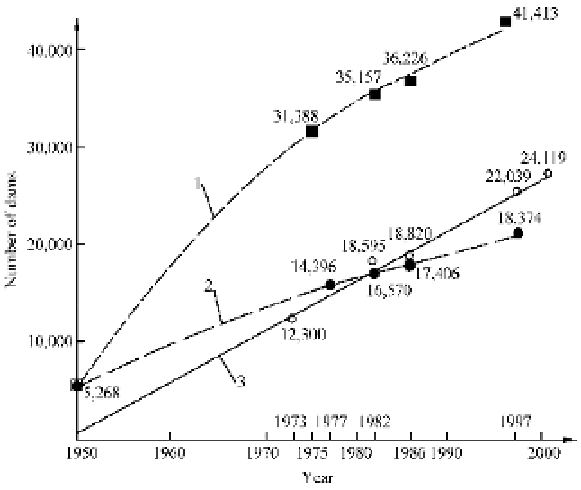Environmental Engineering Reference
In-Depth Information
in Tadjikistan in 1980, is an artificial mountain of earth and rock 300 m high, as tall as the Eiffel Tower
(Tables 7.2-7.3).
Fig. 7.1
Increasing number of large dams in the world and China: Curve-1 is the total number of large dams in the
world; Curve-2 is the number of dams in the world except China; and Curve-3 is the number of dams in China (after
Pan and He, 2000)
The industry defines a 'major dam' on the basis of either its height (at least 150 m), volume (at least 15
million m
3
, reservoir storage (at least 25 km
3
) or electrical generation capacity (at least 1,000 MW). In
1950, only 10 dams met these criteria; by 1995 the number had soared to some 305. The leading builder
of major dams is the U.S., followed by the ex-USSR, Canada, Brazil and Japan. Table 7.1 lists the number
of major dams in the countries ranking from 1 to 20. China was ranked 7 in 1994.
Most of the world's major river basins are now girdled with dams; many great rivers are now little
more than staircases of reservoirs. A meagre 70 kilometres of the 2,000 kilometres of the Columbia River
flows unimpeded by the slackwater of the 19 dams which cut across it. On the Yellow River in China, 11
dams have been constructed and the total capacity of the reservoirs is more than the annual runoff of the
river. In the continental U.S., only the Yellowstone River remains undammed among rivers longer than
1,000 kilometres. In France, the only remaining free-flowing stretch of the Rhone River was impounded
by a dam in 1986. Elsewhere in Europe, neither the Volga; the Weser, the Ebe nor the Tagus has a stretch
more than a quarter its length which has escaped being turned into reservoir.
Worldwide, reservoirs are estimated to have a combined storage capacity of as much as 10,000 km
3
,
equivalent to five times the volume of water in all the rivers in the world (Chad, 1995). The weight of
large reservoirs is so great that they can trigger earthquakes—scores of examples of so-called reservoir-
induced seismicity have been recorded. Geophysicists even estimate that the redistribution of the weight
of the earth's crust due to reservoirs may be having a very slight but measurable impact on the speed at
which the earth rotates, the tilt of its axis and the shape of its gravitational field.
More than 400,000 km
2
, the area of California, have been inundated by reservoirs worldwide (McCully,
1999). One of the world's largest impoundments, the 8,500 km
2
Volta Reservoir behind Akosombo Dam,
flooded around 4% of the land area of Ghana. In the US, reservoirs have submerged an area equivalent to


Search WWH ::

Custom Search